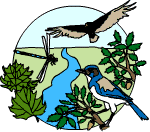 |
MISSION CREEK
MICROORGANISMS
Holoplankton |
|
|
The
water’s of Mission Creek are alive with many different
microscopic and macroscopic organisms. This micro world is
full of small plants, protozoa, bacteria, and animals. These
critters provide the food source for larger organisms. They
can also tell us whether the environment is healthy. The
microorganims have different roles. Some are authotrophic or
can make their own food from the Sun. Some are heterotropic
or ingest food including plants and other organisms. Some live
their entire live in the water (holoplankton) and others only
have their larval stages in the water (meroplankton). |
PLANTAE
Phylum Bacillariophyta
Class Baccillariophyceae
(diatoms)
Order Pennales
Gyrosigma sp.
Navicula sp.
Surrirella sp.
Tabellaria sp.
Phylum Chlorophyta
Class Chlorophyceae
Order Chlorococcales
Pediastrum sp.
Order Zygnemales
Closterium sp.
Mougeotia sp.
PROTOZOA
Phylum Ciliophora
Order Endogenida
Family Tokophryidae
Tokophyra sp.
Order Gymnostomatida
Family Colepidae
Coleps sp.
Order Hymenostomatida
Family Paramedidae
Paramecium sp.
Urocentrum sp.
Order Hypotrichida
Family Euplotidae
Euplotes sp.
Order Peritrichida
Family Vorticellidae
Vorticella sp.
|
Phylum Actinopoda
Class Heliozoa
Phylum Rhizopoda
Family Amoebidae
ANIMALIA
Phylum Annelida
Class
Oligochaeta
Chaetogaster sp.
Pristina sp.
Family Tubificidae
(aquatic worms)
Phylum Arthropoda
Class Crustacea
Subclass Branchiopoda
Cladocera (Water fleas)
Macrothrix sp.
Subclass Copepoda
Cyclops sp.
Subclass Ostrocoda
Cypris sp.
Phylum
Gastrotricha
Phylum Nematoda
Phylum Platehelminthes
Planaria sp.
Phylum Rotifer
Euchlanis sp.
Philodina sp.
Squatinella sp.
|
|
|
Holoplankton spend their entire lives as part of the
plankton. It includes any organisms whether authotrophic or
heterotropic, that is controlled by the water movement in
which they reside. However, some components are capable of
slight movement.
The authotropic representatives include diatoms and green
algae. Heterotropic representatives would include protozoa
and small animals like rotifers and gastrotriches. Some
arthropods can also live their entire life in the water column
including water fleas, ostrocods and copepods. Also Included
in this section are organisms that live in the water column as
plankton, but can live in the benthic (bottom) environment.
Note:
Consult “Quick Identification of Fresh Water Microorganisms”
for approximate sizes of organisms shown in this section.”
|
PLANTAE
|
Phylum Bacillariophyta
(Diatoms)
Unicellular
organisms are the primary source of food for zooplankton.
Most diatoms are plankton that lack flagella (except the male
gametes). Frustules (shells or valves) are overlapping like
a “pill” box and are made of opaline silica. They are
identified by the frustule by its pores, depressions, striae,
costa, raphe, and ornamentations. They possess raphe, which
is a slit on the apical valve. Striae are holes (punta/areolae)
mainly along the edges. Costae are thickened ribs. They are
fresh or marine and contain chlorophyll a and c. They are
autotrophic with mainly asexual reproduction. There is over
37,000 species. |
|
 Class
Bacillariophyceae Class
Bacillariophyceae
Order Pennales
Gyrosigma sp.
The overall shape of the
frustule is moderately sigmoid and lanceolate. It gradually tapers
to obtusely rounded ends. The axial (top) area and the raphe are
sigmoid as well. The proximal ends of the raphe curve in opposite
directions and the central area is longitudinally elliptical. The
transverse and longitudinal striae are distinct and the transverse
striae are slightly radiate. The longitudinal striae curve outward
to the sides of the central area |
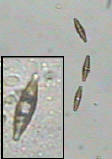 Class
Bacillariophyceae Class
Bacillariophyceae
Order Pennales
Navicula
sp.
The pennate diatoms exhibit a
gliding movement, changing motion without any apparent reason.
Striae are perpendicular to the central raphe, which has a
characteristic larger area in the center. |
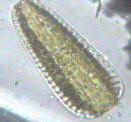 Class
Bacillariophyceae Class
Bacillariophyceae
Order Pennales
Surirella sp.
Frustules are biraphid and
symmetrical to the apical axis. Shape is elliptical to broadly
linear in outline. Some species are spirally twisted. The raphe
are elevated along the margin of the valves. Striae fine to
unresolved. |
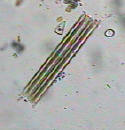 Class
Bacillariophyceae Class
Bacillariophyceae
Order Pennales
Tabellaria sp.
These pennate diatoms usually
attach themselved to form large sig-zag chains. They rarely form
straight colonies. The ends and central portions of one individual
valve are inflated. Striae are fine and costa are absent. |
|
Phylum Chlorophyta (green algae)
The Chlorophyta are
very diverse aquatic plants with over 8000 species ranging
from fresh to marine conditions. However, about 90% are fresh
water. They contain chlorophyll a and b. They store starch
as a food reserve inside plastids. The classification is
confusing and not agreed upon by researchers. Most green
algae have firm cell walls. Some contain flagella while other
have calcified shells. |
|
|
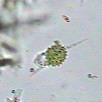 Class
Chlorophyceae Class
Chlorophyceae
Order Chlorococcales
Pediastrum sp.
A colonial algae widely
found in freshwater. Multinucleate cells are geometrically arranged
in flat, circular plates. Protruding pointed projections can be
seen on the surface. |
|
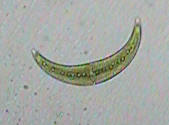  Class
Chlorophyceae Class
Chlorophyceae
Order Zygnematales
Closterium sp.
Pair of cells whose
cytoplasm are joined by an isthmus at the location of a single
shared nucleus. Pyrenoids run parallel to the cell’s long axis.
Lunate or acuate curved. |
|
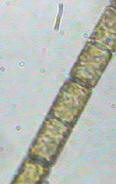 Class
Chlorophyceae Class
Chlorophyceae
Order Zygnematales
Mougeotia sp.
Mougeotia species are unbranched filamentous green algae.
They are cylindrical, with band-, plate- or star-shape
chloroplasts. A single chloroplast fills the length of the cell.
This chloroplast resembles a twisted ribbon. The chloroplast may be
seen lying flat (horizontal) when seen through the microscope. The
chloroplast may be twisted and can be seen as a narrow strip up the
middle of the cell. Cell walls are parallel. Grows rapidly to
produce a type of pond “scum.” |
|
PROTOZOA
Phylum Ciliophora
Ciliates are fresh and marine microbes, covered with cilia.
Cilia are short whip-like extensions embedded in the outer
cell. Cilia aid in movement during feeding. A variety of
organelles plus two kinds of nuclei can be found internally.
Ciliophora are heterotrophs feeding on bacteria and other
small organic particles. Usually reproduce asexually but also
exchange DNA through a process of conjugation. |
|
 Phylum
Ciliophora Phylum
Ciliophora
Order Endogenida
Family Tokophryidae
Tokophyra sp.
Protozoa that possesses
hollow, sticky tentacles (instead of cilia) to capture prey.
Resides on water plants and other organisms. |
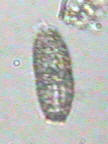 Phylum
Ciliophora Phylum
Ciliophora
Order Gymnostomatida
Family Colepidae
Coleps sp.
Barrel-shaped
body with regularly arranged calcareous plates. Cilia
surrounds anterior end with smaller projects near its posterior end.
A rapid swimmer and voracious feeder. Eats detritus or dying small
organisms. |
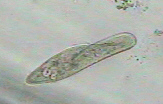 Phylum
Ciliophora Phylum
Ciliophora
Order Hymenostomatida
Family Parameciidae
Paramecium sp.
Paramecium have a stiff
outer covering in a slipper shape. It swims using its short cilia
that encapsulated the entire outer surface. It has an external oral
grove that leads to a mouth pre. It also has an anal pore. Moves
forward in a corkscrew manner, but can reverse directions. |
 Phylum
Ciliophora Phylum
Ciliophora
Order Hymenostromatida
Family Urocentridae
Urocentrum sp.
Cylindrical,
short body with cilia as distinct girdles with a distinct tuft at
the rear. An oval shaped Ciliophora with a constriction in the
middle. Swims rapidly on its tail in an irregular spiral motion.
50-80 microns. |
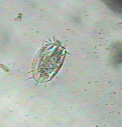 Phylum
Ciliophora Phylum
Ciliophora
Order Hypotrichida
Family Euplotidae
Euplotes sp.
This cilicate has complex
ciliary structures in the cell’s surface. Cell shape is ovoid with
tuffs of cilia joined together to act as an organelle. |
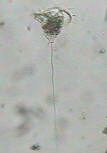 Phylum
Ciliophora Phylum
Ciliophora
Order Peritrichida
Family Vorticellidae
Vorticella sp.
The genus
Vorticella has a bell shaped body with a circle of cilia around the
oral opening. A slender, contractile stem helps this group to
attach to a substrate (sessile) or to other members of the same
species. It forms a colony of many individuals. |
| Some groups
are difficult to speciate so the following descriptions
represent larger groups of protozoa |
|
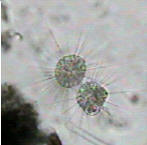 Phylum
Actinopoda Phylum
Actinopoda
Class Heliozoa
Freshwater
species with a symmetrical globular form. Possesses radiating
axopodia that contains cytoplasm. The axopodia contract bringing
bacteria and other nutrients into a food vacuole where it is
digested. |
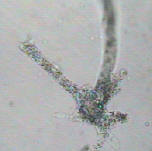 Phylum
Rhizopoda Phylum
Rhizopoda
Family Amoebidae (naked amoeba)
Amoebas are noted for its
slow, free-form motion using pseudopods. The cell wall moves as the
cytoplasm shifts within the cell . It captures its food by
engulfing its prey with this motion. Specimens found were naked
(without a shell) and polypodial (many pseudopods at one time). |
|
ANIMALIA
Phylum Annelida
Annelids have external segments that
correspond with repeated digestive and reproductive organs.
They live on land, in ocean and fresh water. Fresh water
annelids include leeches and bristle worms. Most annelids are
predators or scavengers. Swimming annelids actively feed
on fish eggs and insect larvae. |
|
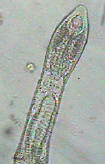 Phylum
Annelida Phylum
Annelida
Oligochaeta
Chaetogaster sp.
Chaetogaster
eats small crustaceans and insect larvae. The prostomium
(mouth area) is well developed, pointed in shape with long sensory
hairs. The dorsal side does not have setae (hairs), but can be
found on the ventral side. |
  Phylum
Annelida Phylum
Annelida
Oligochaeta
Pristina sp.
A segmented
worm with characteristic hair setae in bundles along its dorsal
side. Prostomum rounded to form proboscis at the anterior end.
|
|
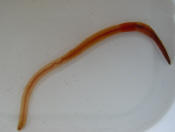 Phylum
Annelida Phylum
Annelida
Oligochaeta
Family Tubificidae (aquatic worms)
Aquatic worms are close
relatives to the earthworm except they are smaller and live in
shallow, fresh water. They feed on detritus, bacteria, and
algae in the water. They use the same undulating motion that
is common movement for earthworms. |
|
Phylum
Arthropoda
Arthropods compose the largest group of organisms on
Earth. They are characterized by having an
external skeleton with jointed limbs. They include
both marine and fresh water groups. Some
arthropods are total aquatic while others may only live
in the water in their larval or nymph stages.
|
|
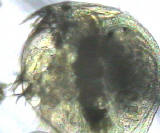 Phylum
Arthropoda Phylum
Arthropoda
Crustacean
Cladocera
(water fleas)
Water fleas have large
antennae which they use for locomotion. They have large
dual compound eyes above the antennae. Five-six feet are used
to filter food (small algae) before it goes through its digestive
system. You can also observe its very small heart. |
 Phylum
Arthropoda Phylum
Arthropoda
Crustacean
Copepods
Copepods do not have a
shell but are slender and segmented. Cyclops is a common fresh
water copepod that has one single eye spot. Females carry two
sacs on their tail. |
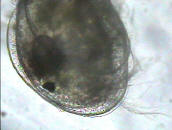 Phylum
Arthropoda Phylum
Arthropoda
Crustacean
Ostracods
Ostracods have
characteristic two symmetrical shells that cover its body. The
shrimp like critter lives inside. The shell is composed of
calcium carbonate. |
|
 Phylum
Gastrotricha Phylum
Gastrotricha
Gastrotrichs are
wormlike animals with lobed heads that are bilaterally
symmetrical. The have adhesive tubes mainly near its
posterior that help it cling to surfaces. Their bodies
are not segmented and are flat. Their head lobe has
small bristles on an oral hood. |
Phylum Nematoda (roundworms)
Nematodes are
cylindrical and slender with rounded ends, which attributes to
this group being referred to as roundworms. They lack
segmentation and cilia. Nematodes can be found in most
habitats including soil, sand, salt flats, ocean, hot springs,
and fresh water. There are also parasitic forms. |
Phylum Platyhelminthes
(flatworms)
These
flatworms are ribbon-shaped and are adapted to many habitats
including land, marine, and fresh water. They are
noted for their extensive regeneration. They are not as
complex as the annelids. They have an opening into the
gut that acts as food in and waste out portal. |
|
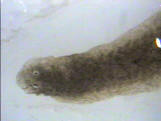  Phylum
Platyhelminthes Phylum
Platyhelminthes
Planaria
Planaria are easily
recognized because their head region has two eyes that appear
“cross-eyed.” They are free living and eat decaying meat. They
have a simple nervous system. Their excretory system consists of
specialized “flame cells,” that remove waste. |
Phylum Rotifer
Rotifers are named
for the cilia at the crow of their heads. They are
bilaterally symmetrical and covered with an external layer of
chitin called a lorica. Rotifers lack a circulatory
system and respire through the surface of their body.
Most are free swimming individuals although some create
colonies that can be seen rotating rapidly like a spinning
ball. They feed on bacteria, protists, other rotifers
and small animals, and suspended organic matter.
Rotifers are a major source of food for other animals in
freshwater environments. |
|
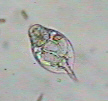 Phylum
Rotifer Phylum
Rotifer
Euchlanis sp.
The lorica is transparent
and encases most of the rotifer. It feeds on small microorganisms
and debris. It uses its 2 rear appendages to move itself around.
|
 Phylum
Rotifer Phylum
Rotifer
Philodina sp.
A large rotifer that is
transparent with easily observed internal organs. Cilia form a
rotating wheel organ on the head. The cilia stroke back and forth
at very high speed creating a whirlpool that draws food to its
mouth. This genera is commonly used in toxicity studies. |
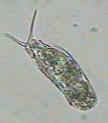 Phylum
Rotifer Phylum
Rotifer
Squatinella sp.
Squatinella
has a transparent shield over the head region. Their eyes have
lenses. The shield covers the cilia which is on the depressed side
and has two pronounced appendages toward posterior end. |